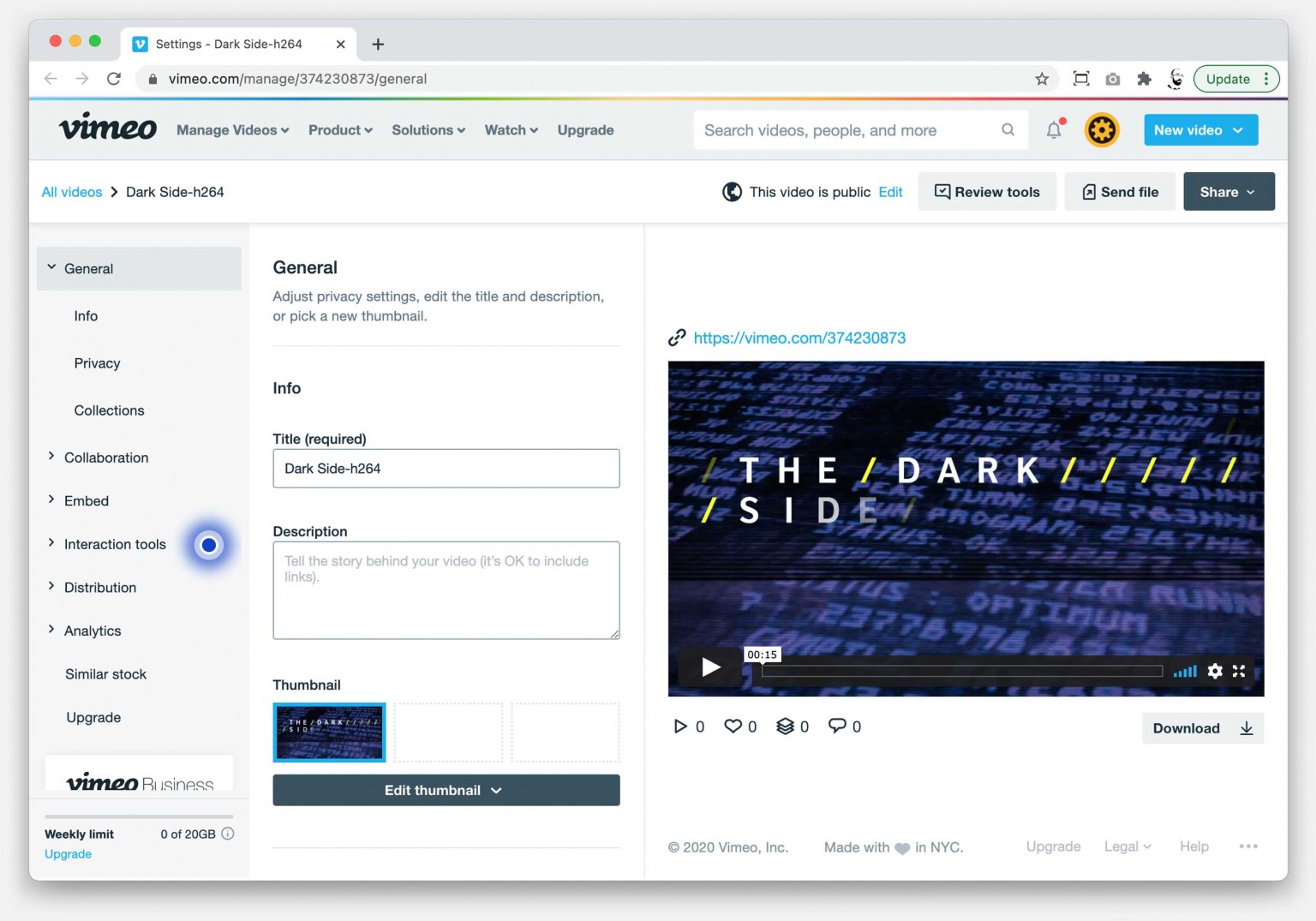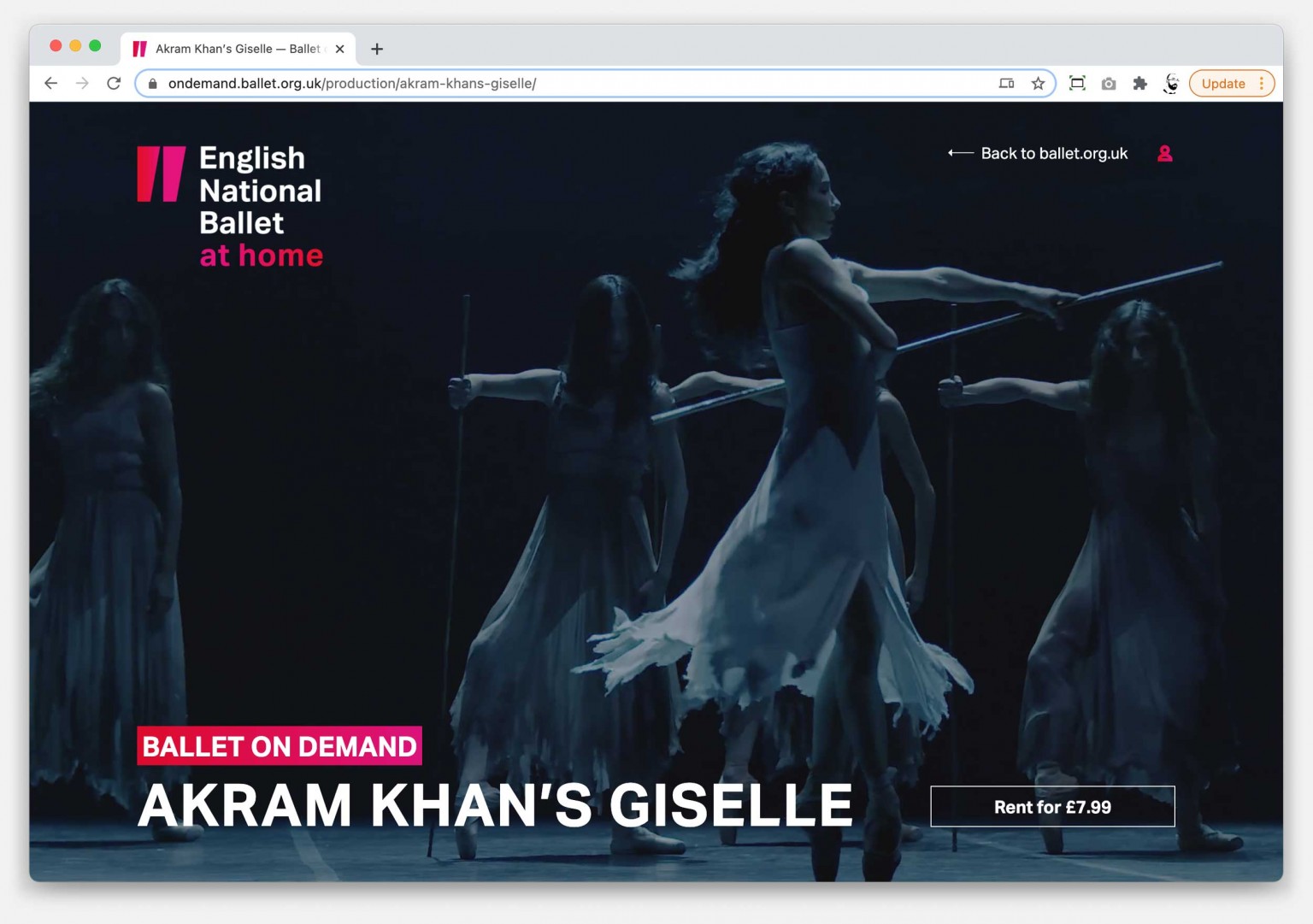We’ve had to learn a lot about video hosting recently. Here’s Michael’s run down.
Lessons about video hosting (so far)

Many arts organisations want to start selling on-demand or streamed video. It’s no longer a fun way of coping with COVID, it’s now an essential part of the recovery plan.
We’ve developed some innovative ways to help our clients sell video content but we don’t (want to) host the video itself.
We’ve found that the complexity of video hosting is often under-estimated, based on the easy interactions provided by the two big players – YouTube and Vimeo. But once ‘monetisation’ is added to the mix, the topic becomes complex very quickly.
Responsibility for video hosting seems to fall between the stools, somewhere between production, marketing and, more recently, box-office.
Cultural sector organisations used to rely on their marketing team to throw up any video content to YouTube, or maybe Vimeo if they wanted it streamed on their site. But that’s not good enough any more. If you want to reach audiences and sell video as part of your offer then you need to professionalise the set-up, think carefully about the hosting and how audiences interact and pay to view.
I thought it might be useful to share some of our learnings. Hopefully it’ll be a useful resources for the cultural sector as a whole.
The first thing to note is that this year, this quarter, this month, even this week, we’ve seen accelerated changes in this area. It’s likely that, by the time I’ve finished typing this article, something else will influence the way we talk about hosting and streaming with our clients.
But here’s what we know, right now on 12th December 2020…
Hosting and streaming video is really complex.
That’s perhaps not a surprise when you take the time to think about it. But most of us don’t. Understandably, most of us just take the technology for granted.
The big players make very technical outcomes seem very easy to achieve.
They have set expectations very high in terms of ubiquity, ease of use, and speed of service.
We’re all used to uploading raw videos in whatever format we fancy, using a simple website interface that works on any device, Then we assume that they will compress, convert, reconfigure it to play at different rates on different devices, balance the colour, sort out sound spikes, add subtitles. Oh, and provide almost unlimited hosting and bandwidth, detect where it’s being played and cache content to multiple local servers and so much more. Most of it is invisible and unquestioned.

YouTube have really skewed us up
YouTube in particular are masters of the art. They’ve become the world’s second biggest search engine, and they are owned by the first.
They’ve done that by investing unimaginable sums of money. They can afford to do that because they generate unimaginable profits – $15 billion in ad revenue last year.
But they have always been clear that if you want to make money from them, you do it entirely on their terms. If you upload to them, they ‘own’ your content; if you want a ‘free’ service they’ll make money from intrusive ads.
They do let you embed their video player in your website but they’ve been making it ever more difficult and clumsy.
And their terms have always stated that you can’t monetise it (and they decide what they mean by that).

Vimeo changed the landscape
We built our first monetised video player, for an artists-based video archive, using Vimeo back in 2014. They’ve been our go-to hosts ever since.
Their platform feels more professional than YouTube, it feels more mature, more geared to people who care about the quality of the experience. And yes you pay a little for that.
We used to recommend Vimeo Pro accounts to give our clients freedom to use their videos professionally and embed them through their sites; there were no terms (that we ever found) to restrict that use, even if you were selling the video content.

Vimeo have gone over the top
This year the landscape changed. Vimeo has been heavily pushing their OTT service.
OTT stands for Over The Top; it basically means a channel that hosts and streams video content via the internet, bypassing traditional media and broadcasting networks. They use the language of ‘subscribers’ in the same way Netflix does.
Vimeo OTT does have out-of-the-box solutions but if you want to make it feel like your own then you have to add some extra cleverness with design and styling. We’ve built two Vimeo OTT channels for English National Ballet (Ballet On Demand for performance and BalletActive for classes), and we think the new National Theatre’s At Home channel probably uses their set-up too.
There are many providers of OTT services but Vimeo seem to be the market leaders. And their pricing seems proportionate: Starter package at $1 per subscriber, or a Growth package from $6000.
Trials and tribulations
Vimeo’s OTT (or any of the multitude of others) is great if you genuinely want to create a broadcast channel. But for one-off performances, or trial runs, that’s a big investment.
And it means that all of your data and payments run through them rather than your traditional ticketing system. Your customers have to set up a separate login because it’s an entirely separate system.
Most of our clients want to avoid that. They want low-cost ways that they can use their existing customer and ticketing data to sell video content (especially as they’ll often be selling live and video experiences, side by side).
They don’t want big upfront costs as this is all new to them. They don’t yet know if their audiences have an appetite for streamed or on-demand content.
Back in the summer we built a solution that does exactly that for client websites – a paywall that is unlocked through the ticketing CRM, Spektrix. And we rolled out a standalone version for organisations that weren’t already our clients – CogPlayer.com.

At its simplest this means that customers buy a ‘ticket’ to watch embedded video through the website.
We can embed almost any feed. Most of our clients were using Vimeo Pro as the sensible option.
But we started to hear rumours. We’re not sure when it was added but people noticed that Vimeo’s terms included a new clause that (in legalese) prevents this type of monetisation unless you sign-up to an ‘enterprise’ level account.
They don’t publish their enterprise prices on their site; they aren’t cheap.
We don’t know of anyone who has had the call from Vimeo but they do say “We may restrict bandwidth or charge extra for the following uses of our player or video hosting tools” so it’s an obvious concern to be aware of.
It’s fair enough of course. Vimeo provide an astonishing service; perhaps we should never have expected so much for so little. Maybe they’ve reached the level of market saturation that their investors were aiming for, and now is time to leverage that position.
Where do we go from here?
To help our clients, we’ve been speaking with a number of different video hosts. There are lots of them.
The bottom line is, you get what you pay for – either in cash or in the investment of time to set it all up. Usually both.
Mostly they want you to upload your content to their platforms so they can sell advertising around it (or monetise their algorithms in other ways). Or they want you to buy their OTT service. But many will also (currently) let you embed and monetise via your own site.
Here’s a run down of those who we’ve crossed paths with recently, in no particular order:
Dacast dacast.com
Dacast have an excellent reputation and work at large scales so that’s a good sign. Their advantage seems to be around live streaming.
Our experience of interacting or using their service has been patchy; their embedding code is unlike anyone else’s which makes for extra development time and testing. We really struggled to get their technical team to resolve problems or answer questions.
We know at least one high-profile arts organisation who abandoned plans to use them because of technical issues. But many people swear by them so they are definitely worth talking to.
Muse muse.ai
Muse aren’t big players but they are interesting. Actually the company is very small. It’s run by António Roldão who has used his background in academic artificial intelligence to create an intuitive search platform for video. The focus of his hosting package is currently on academic papers.
We spoke with Antonio (on the back of Supercool’s great blog about this topic). He was pragmatic and genuinely interested in adapting to help.
As he said, his published pricing is very cheap but it has a ‘fair usage’ policy – streaming to hundreds of people isn’t in the spirit of that (and it probably couldn’t cope). But he’s happy to work with arts organisations to create a custom solution at a reasonable price. He really knows what he’s talking about so we think he’s worth talking to about that.
At least one large UK venue is already using his platform, via a reasonable bespoke agreement, to stream events.
Sprout Video sproutvideo.com
At first glance Sprout look expensive. But actually I think they are just more honest than others. Their pricing is cheap compared to other ‘enterprise’ offers and they are upfront and clear about that pricing (unlike their peers).
They actively encourage people to use their own paywalls. When we asked them, they said: “Yes….You can embed videos in your own external website on all of our plans”.
And they offer a free trial at any level, with an ‘onboarding phone call’ to help with the set-up.
We don’t know anyone who is using them yet. We’d love to hear from you if you are.
Daily Motion dailymotion.com
This French company sees itself as a rival to YouTube (with just as many ads) but that does mean they have a slick interface and reasonable pricing. They do live stream and hosting.
We asked them about embedding behind a paywall and they said… “you can definitely set up a paywall on your website, and use Dailymotion as a player technology….Becoming a Dailymotion partner would suffice… There is a caveat though… You may choose to set the video in private but anyone with the link or knows the URL will be able to view it on Dailymotion”.
We think Daily Motion is a great, cheap alternative to Vimeo or YouTube, our developers love the ease of how their embedding works but it is easy to share the links so its probably not right if you feel that your audience might do that.
Brightcove brightcove.com
I’m sure Brightcove are great. They have an excellent reputation amongst professional video companies. But they don’t want to publish any details about their pricing.
We contacted them via their online chat with our specific question about embedding behind a paywall; they emailed straight back, ignored the question and suggested a sales call. We posed the question again via email; they ignored it again and suggested a sales call. We emailed back asking if they could confirm that they’d be able to provide the service we need; they emailed back suggesting a sales call.
Maybe you’ll have better luck or the inclination to have a sales call. We’ve heard that an enterprise account is likely to be a £20K+ commitment.
JW Player jwplayer.com
A decade ago JW Player provided plug-in players to allow us to host the videos and stream through our sites. But as video hosting got more complex, that service became less useful.
Now they’ve reinvented themselves as a full video hosting platform. They apparently (according to their sales person) are the video partners of Barbican in London.
Their site and pricing looked promising. But when we got into a conversation about paywalls, they told us we’d need an enterprise account, and that account would require a year’s commitment of many thousands of pounds.

Options with in-built hosting
There are a couple of great companies who now provide a link between Spektrix and their own OTT players with integrated hosting. And we hear there will be more in the new year.
These platforms use a direct payment model, bypassing Spektrix (for all but the login), so customers pay them directly and they take a cut of the sale before settling the accounts with their clients (you).
The digital agency Substrakt have a platform called [showcase] that they’ve been developing with clients. To counter the issues with Vimeo, they have also launched their own video streaming service, [showreel].
And TicketCo have just (yesterday) launched a partnership with Spektrix offering integration and hosting. They do a lot of sports ticketing too so we assume they have invested well in the hosting set up. They offer casting which is a real bonus.
Choosing the right option for you
We want to help you choose the right solution for you and your audiences.
Of course we’d love the solution to be that you choose to work with us (either through a bespoke integration or by using CogPlayer). But if it isn’t then we’d much rather be clear about that and steer you in the right direction.
If you work with us you’ll need to sort your own video hosting because we don’t do that.
As I’ve noted above, different companies offer different levels of service and different pricing model so you should choose the one that best matches your needs.
If you want the hosting to be bundled in for ‘free’ then you’ll be paying for it in other ways, usually by the company taking a percentage of your ticket sales (and adding an extra level of admin and external accounting). That can be the perfect set up for some.
What else do we need to know?
This article is based on the knowledge and our own experience at the time of writing. I am very aware that we’re still learning. I’d love to hear from you about your experience and to share your knowledge. If you have comments to add or feel we’ve missed or misrepresented anything, please do get in touch. And if you’ve got other recommendations for channels or hosts, do let us know.







